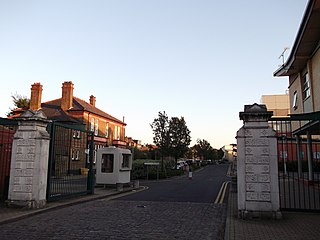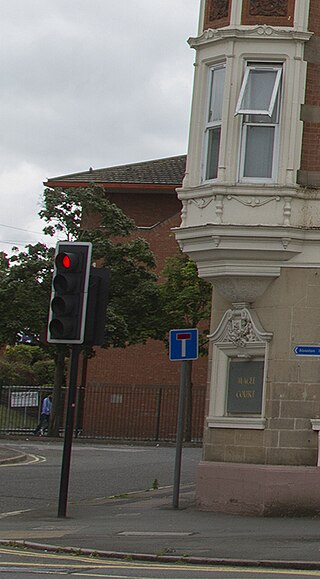
Belmont is a village in the London Borough of Sutton, in South London, England. It is located off the A217 road and near to Banstead Downs in Surrey. It is a suburban development situated 10.8 miles (17.4 km) south-southwest of Charing Cross.
The Institute of Cancer Research is a public research institute and a member institution of the University of London in London, United Kingdom, specialising in oncology. It was founded in 1909 as a research department of the Royal Marsden Hospital and joined the University of London in 2003. It has been responsible for a number of breakthrough discoveries, including that the basic cause of cancer is damage to DNA.

The Epsom Downs Branch is a 3-mile-65-chain (6.1 km) railway line in Greater London and Surrey, England. It runs from Sutton to its southern terminus at Epsom Downs, with intermediate stations at Belmont and Banstead. With the exception of the northernmost 39 ch (780 m), the branch is single track. All stations are managed by Southern, which operates all passenger trains. Most services run between Epsom Downs and London Victoria via Selhurst.

Royal Brompton Hospital is the largest specialist heart and lung medical centre in the United Kingdom. It is managed by Guy's and St Thomas' NHS Foundation Trust.

The Royal Marsden NHS Foundation Trust is an NHS Foundation Trust which operates the Royal Marsden Hospital facilities on two sites:

Manchester Royal Infirmary (MRI) is a large NHS teaching hospital in Chorlton-on-Medlock, Manchester, England. Founded by Charles White in 1752 as part of the voluntary hospital movement of the 18th century, it is now a major regional and national medical centre. It is the largest hospital within Manchester University NHS Foundation Trust, and based on its Oxford Road Campus in South Manchester where it shares a site with the Royal Manchester Children's Hospital, Manchester Royal Eye Hospital and Saint Mary's Hospital as well as several other educational and research facilities. The Hospital is also a key site for medical educational within Manchester, serving as a main teaching hospital for School of Medical Sciences, University of Manchester.

Queen Mary's Hospital, formerly Queen Mary's Convalescent Auxiliary Hospitals, is a community hospital in Roehampton in the London Borough of Wandsworth. It is run by St George's University Hospitals NHS Foundation Trust.

Stobhill Hospital is located in Springburn in the north of Glasgow, Scotland. It serves the population of North Glasgow and part of East Dunbartonshire. It is managed by NHS Greater Glasgow and Clyde.

Mount Vernon Hospital is a hospital located in Northwood in the London Borough of Hillingdon. It is one of two hospitals run by The Hillingdon Hospitals NHS Foundation Trust, the other being Hillingdon Hospital.
University College London Hospitals NHS Foundation Trust (UCLH) is an NHS foundation trust based in London, United Kingdom. It comprises University College Hospital, University College Hospital at Westmoreland Street, the UCH Macmillan Cancer Centre, the Royal National ENT and Eastman Dental Hospitals, the Hospital for Tropical Diseases, the National Hospital for Neurology and Neurosurgery, the Royal London Hospital for Integrated Medicine and the Royal National Throat, Nose and Ear Hospital.

University College Hospital at Westmoreland Street, named The Heart Hospital until refurbished and renamed in 2015, was a specialist cardiac hospital located in London, United Kingdom until 2015. It is part of the University College London Hospitals NHS Foundation Trust and is closely associated with University College London (UCL). After the 2015 refurbishment, the hospital now provides thoracic surgery and urology services.

Lambeth Hospital is a mental health facility in Landor Road, South London. It was previously known as the "Landor Road hospital" and is now operated by the South London and Maudsley NHS Foundation Trust and is affiliated with King's College London's Institute of Psychiatry. It is also part of the King's Health Partners academic health science centre and the National Institute for Health and Care Research (NIHR) Biomedical Research Centre for Mental Health.

Clatterbridge Health Park is a campus of otherwise independent, health care-related organisations, including three separate NHS trusts.

The Clatterbridge Cancer Centre is an NHS Foundation Trust, which specialises in the treatment of cancer. The centre is one of several specialist hospitals located within Merseyside; alongside Liverpool Heart and Chest Hospital, Alder Hey Children's Hospital, Liverpool Women's Hospital, and the Walton Centre.
The Royal Brompton and Harefield NHS Foundation Trust was an NHS foundation trust which ran the Royal Brompton Hospital in Kensington and Harefield Hospital in Hillingdon, London, England.
South West London and St George's Mental Health NHS Trust is an NHS trust that provides mental health services for adults, older people, children and adolescents living in the London boroughs of Kingston, Merton, Richmond, Sutton and Wandsworth.

Andover War Memorial Hospital is a community hospital in Andover, Hampshire. The hospital provides inpatient rehabilitation, day hospital services, a minor injury unit and an outpatient unit. It is operated by Hampshire Hospitals NHS Foundation Trust, but some services are provided by Southern Health NHS Foundation Trust. The Countess of Brecknock Hospice is located on the same site as the hospital. The independent regulator of health and social care in England, the Care Quality Commission, rated Andover as "requires improvement" overall in 2018.

The Velindre Cancer Centre is a specialist facility offering inpatient and outpatient care for cancer patients in Whitchurch, Cardiff, Wales.

The Gordon Hospital is a 55-bed acute adult mental health hospital located in Westminster, London. It is managed by the Central and North West London NHS Foundation Trust.

The Florence Nightingale Community Hospital, formerly the London Road Community Hospital, is a community hospital on London Road in Derby, England. It is managed by the University Hospitals of Derby and Burton NHS Foundation Trust. The other main hospital in Derby is the Royal Derby Hospital.

















